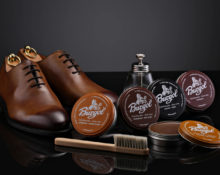Wet shoes are a serious problem, because in addition to the discomfort when wearing and the smell of feet, it is not difficult to get a serious cold. This will negate any savings on boot quality or care. If you take care of keeping your feet dry in advance, you can avoid treatment costs.
How to choose a product

Your favorite boots can leak for various reasons:
- low quality;
- poorly secured sole;
- damage during wear, for example, by anti-snow compounds;
- manufacturer's defect not noticed at the time of purchase;
- cracks on artificial materials, as well as on natural ones, but lacking quality care.
Wax
You can quickly and practically free of charge protect yourself from wet feet for the coming season with the help of candles. The wax or paraffin from which they are made are quite suitable for this task. But they must be colorless; the bright wax of decorative candles will ruin the shoes.It is recommended to test the effect of the substance on the material in advance, on an inconspicuous place on a new item or on old worn-out shoes.

How to apply wax or paraffin correctly:
- cover the entire welt of the boot with a sufficiently thick layer, not leaving out weak points - seams and cracks;
- heat the edge of the shoe with a hairdryer, the wax will melt and penetrate into all places where water can penetrate and clog them.
Attention
This processing method is not suitable for all materials. It is better to care for suede shoes using products from the store, so as not to damage the boots due to rough handling.
Store formulations
Professionals work on purchased leather, textile or suede care products. You can always find on the packaging which material should be treated with this substance. All products are divided into sprays and creams.

Sprays are designed to be evenly sprayed onto the surface of the boots. This includes caring for shoes, maintaining their strength and elasticity, as well as creating an impermeable coating that will prevent them from getting wet. It is worth applying the aerosol on the street or balcony, as sprays often emit a pungent odor.
Shoe creams have the main function of restoring leather, preventing cracking, and removing salt, which is abundantly used on roads in winter. These products often contain beeswax, which adds a water-repellent effect. It is necessary to treat shoes several times a season, since over time the product leaves the surface of the shoes.
"Home" remedies

The most popular folk methods of protecting against getting your feet wet:
- Lamb fat combined with flax oil 50 grams each, you can add a little turpentine (about 10 grams) to the mixture. Heat it and coat the welt of the boot until the mixture hardens;
- Rub castor oil into rough leather shoes;
- Glycerin is a component of gray homemade soap. You can use it either separately, placing the shoes in a basin of water with a high concentration of glycerin, or together with fish oil, turpentine and beeswax;
- Rosin in combination with turpentine and beeswax can be applied to shoes by heating the mixture in advance.
Important
“Home” methods can damage delicate skin, and even more so suede or delicate textiles. Aggressive formulations are mainly intended for rough skin. In addition, you should always test the safety of the treatment on an inconspicuous area of the shoe or similar material.
Taking care of your shoes will help you save on buying new clothes, treating a possible cold, and will also give your shoes an aesthetically pleasing appearance, which is important. The main thing is not to overdo it and not ruin your boots with an inappropriate method of protection from getting wet.


 0
0





